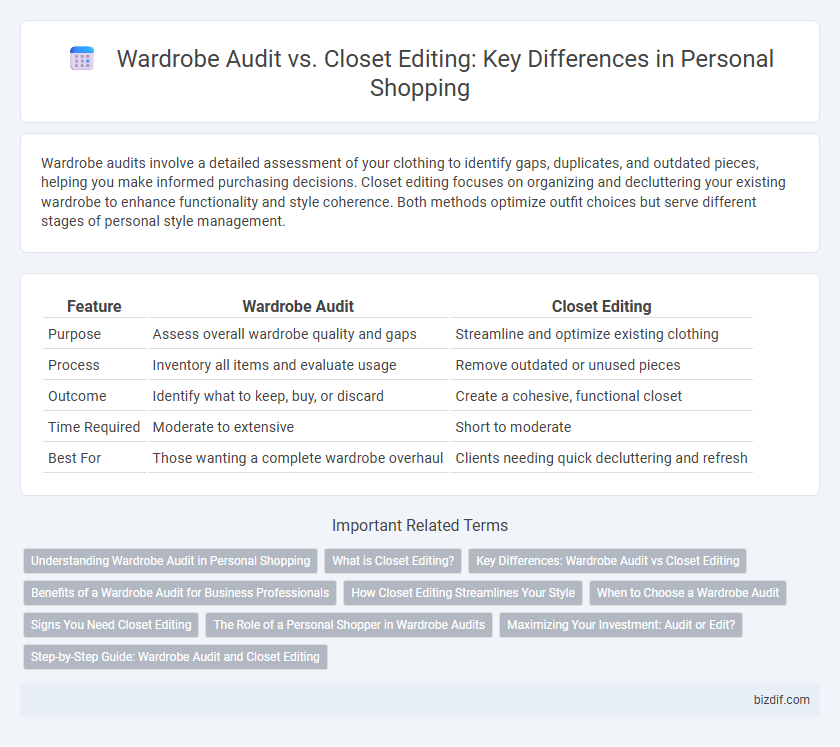Wardrobe audits involve a detailed assessment of your clothing to identify gaps, duplicates, and outdated pieces, helping you make informed purchasing decisions. Closet editing focuses on organizing and decluttering your existing wardrobe to enhance functionality and style coherence. Both methods optimize outfit choices but serve different stages of personal style management.
Table of Comparison
| Feature | Wardrobe Audit | Closet Editing |
|---|---|---|
| Purpose | Assess overall wardrobe quality and gaps | Streamline and optimize existing clothing |
| Process | Inventory all items and evaluate usage | Remove outdated or unused pieces |
| Outcome | Identify what to keep, buy, or discard | Create a cohesive, functional closet |
| Time Required | Moderate to extensive | Short to moderate |
| Best For | Those wanting a complete wardrobe overhaul | Clients needing quick decluttering and refresh |
Understanding Wardrobe Audit in Personal Shopping
A wardrobe audit in personal shopping involves a detailed assessment of clothing items to identify gaps, versatile pieces, and outdated garments, optimizing outfit coordination and personal style. Unlike closet editing, which primarily focuses on decluttering, a wardrobe audit provides actionable insights to guide future purchases and ensure a cohesive wardrobe strategy. This process enhances shopping efficiency, reduces unnecessary spending, and aligns wardrobe choices with lifestyle and fashion goals.
What is Closet Editing?
Closet editing is the process of carefully assessing and organizing clothing items to create a functional and stylish wardrobe tailored to individual preferences and lifestyle needs. It involves removing outdated or unworn pieces, identifying gaps, and reorganizing garments for easy access and outfit coordination. Unlike a wardrobe audit, closet editing emphasizes practical arrangement and styling to enhance daily dressing efficiency and confidence.
Key Differences: Wardrobe Audit vs Closet Editing
Wardrobe audit involves a detailed inventory of all clothing items to assess their condition, style, and frequency of use, helping identify gaps and duplicates for future purchases. Closet editing, on the other hand, focuses on curating and organizing existing garments, removing outdated or ill-fitting pieces to streamline the wardrobe's functionality and aesthetic. The key difference lies in wardrobe audit's emphasis on evaluation and strategic planning, while closet editing centers on decluttering and enhancing daily outfit coordination.
Benefits of a Wardrobe Audit for Business Professionals
A wardrobe audit helps business professionals identify versatile, high-quality pieces that enhance their professional image and streamline daily outfit choices. By assessing current clothing items, it eliminates unnecessary purchases and highlights gaps for strategic additions, boosting confidence and saving time. This process supports a polished, cohesive appearance essential for career advancement and networking success.
How Closet Editing Streamlines Your Style
Closet editing streamlines your style by focusing on removing unused or outdated items, creating a curated wardrobe that highlights your best pieces for easy outfit creation. Unlike a wardrobe audit, which assesses the overall condition and usage of clothing, closet editing prioritizes immediate decluttering and organizing to enhance daily dressing efficiency. This targeted approach saves time and reduces decision fatigue, ensuring a stylish, manageable closet tailored to your lifestyle.
When to Choose a Wardrobe Audit
Choose a wardrobe audit when you need a comprehensive evaluation of your clothing to identify gaps, outdated items, and styling opportunities. This process is ideal for those undergoing significant lifestyle changes, such as a new job or weight loss, requiring a refreshed and functional wardrobe strategy. Wardrobe audits offer detailed insights into purchasing decisions, preventing unnecessary spending and promoting cohesive outfit planning.
Signs You Need Closet Editing
A wardrobe audit reveals outdated or rarely worn items, while closet editing focuses on decluttering and organizing for practical use. Signs you need closet editing include overflowing hangers, difficulty finding outfits, and clothes that no longer fit your style or lifestyle. Regular closet editing streamlines your wardrobe, boosts daily dressing efficiency, and maximizes space utilization.
The Role of a Personal Shopper in Wardrobe Audits
A personal shopper plays a crucial role in wardrobe audits by assessing clients' existing clothing to identify gaps, outdated items, and versatile pieces for various occasions. They provide expert advice on aligning the wardrobe with the client's lifestyle, body type, and color preferences, ensuring a streamlined, functional collection. Unlike closet editing, which focuses on decluttering, wardrobe audits prioritize strategic evaluation and tailored recommendations for future purchases.
Maximizing Your Investment: Audit or Edit?
Maximizing your investment begins with understanding the difference between a wardrobe audit and closet editing; a wardrobe audit offers a comprehensive evaluation of your entire clothing collection to identify gaps and redundancies, while closet editing focuses on refining and organizing what you already own to enhance daily outfit choices. A wardrobe audit provides strategic insight for targeted shopping, ensuring every new piece adds value and versatility. Closet editing improves functionality and accessibility, making your existing wardrobe work smarter and extending the longevity of your investment.
Step-by-Step Guide: Wardrobe Audit and Closet Editing
A wardrobe audit involves categorizing clothing by type, fit, and frequency of use to identify gaps and redundancies. Closet editing focuses on removing items that no longer align with style goals or lifestyle needs, ensuring a curated and functional collection. Combining both methods streamlines personal style while maximizing wardrobe versatility.
Wardrobe audit vs Closet editing Infographic

 bizdif.com
bizdif.com